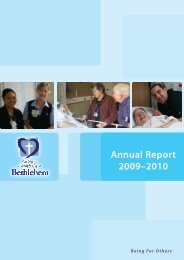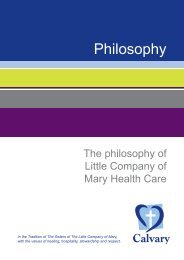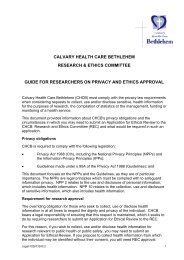Annual Report 2011 - Calvary Health Care Bethlehem
Annual Report 2011 - Calvary Health Care Bethlehem
Annual Report 2011 - Calvary Health Care Bethlehem
You also want an ePaper? Increase the reach of your titles
YUMPU automatically turns print PDFs into web optimized ePapers that Google loves.
Dietitian Services<br />
The nutrition service at our hospital is contracted from the<br />
Alfred Hospital.<br />
Over the last 12 months, the Dietitians provided expert<br />
nutrition and dietary advice to patients and their families<br />
in order to improve and manage a range of conditions<br />
including progressive neurological diseases, cancers,<br />
end stage heart disease and late stage gastrointestinal<br />
diseases, food intolerances as well as overweight<br />
and obesity. The Dietitians also developed a range of new<br />
resources for patients requiring enteral nutrition. A series of<br />
booklets have also been produced to support patient care.<br />
The Human Spirit – Determination<br />
and Independence<br />
In 2008 a young family arrived in Australia.<br />
Just as they were settling in to their new life Marty,<br />
a 39 year old engineer was diagnosed with Motor<br />
Neurone Disease. His wife was expecting their<br />
first child.<br />
A progressive disease like Motor Neurone Disease<br />
brings new challenges and impacts on every<br />
aspect of a person’s life, from physical changes to<br />
emotional health, relationships and spiritual wellbeing.<br />
The interdisciplinary team works with Marty<br />
and his family to provide support and to manage the<br />
changes and symptoms he faces.<br />
For Marty it was important to try and regain some<br />
control and independence of his life. He was<br />
keen to keep working and be close to his family.<br />
So assistance to access his computer at home<br />
without using a normal mouse was set up by the<br />
interdisciplinary team.<br />
With the support of both his family and the hospital,<br />
Marty was determined to remain engaged in life<br />
and work. Marty used a specialised program called<br />
Dasher, which is like an on screen keyboard. He<br />
is able to send emails to work colleagues, work on<br />
documents and surf the internet; all without using a<br />
mouse. Marty comments ‘no-one even knew I was<br />
not using a normal keyboard.’<br />
The interdisciplinary team regularly assess Marty<br />
and his family’s needs during admissions to the<br />
Neurological Inpatient Unit. This also gives his wife<br />
and two young children some respite. The team<br />
have provided Marty with a range of specialised<br />
equipment including supported seating, equipment<br />
and training to support transfers and specialised<br />
Considerable resources and expertise over the last<br />
12 months has also been dedicated to the hospital’s<br />
Food Service management area, resulting in significant<br />
improvements. Hospital services, dietitians and speech<br />
pathologists have all worked collaboratively to ensure safe,<br />
nutritionally appropriate and appealing meals are provided<br />
to all patients, families and staff.<br />
technology that enables him to continue to use his<br />
computer without his hands through a head mouse.<br />
The specialised technology gives Marty<br />
independence, comfort and the ability to<br />
communicate with friends and family and he uses<br />
Skype to communicate with his wife when he is an<br />
inpatient at the hospital.<br />
Marty’s speech is limited now and his disease<br />
continues to progress. Marty uses the My Tobi<br />
Eye Gaze Communication System. This consists<br />
of a computer screen and an inbuilt camera and<br />
specialised eye tracking software. It also has an<br />
inbuilt environmental control unit which enables<br />
Marty to control his environment with his eyes,<br />
including operating the television, opening the<br />
blinds and adjusting the air conditioner or heater.<br />
Combined with his resilient determination, Marty<br />
remains incredibly positive and well supported by<br />
his entire family.<br />
Marty commented that ‘the eye gaze system<br />
enables me to communicate with some voice<br />
output. It also allows me to continue writing letters<br />
to my children who are only 4 and 18 months<br />
old’. Marty hopes that these letters will provide his<br />
children with some insight into who their dad was<br />
and what his hopes and dreams for them were.<br />
Leaving these letters to both his children is part of<br />
his enduring legacy to them.<br />
<strong>Calvary</strong> <strong>Health</strong> <strong>Care</strong> <strong>Bethlehem</strong> 2010 – 11 <strong>Annual</strong> <strong>Report</strong><br />
27






